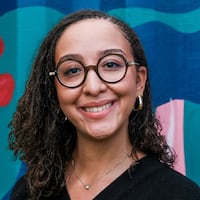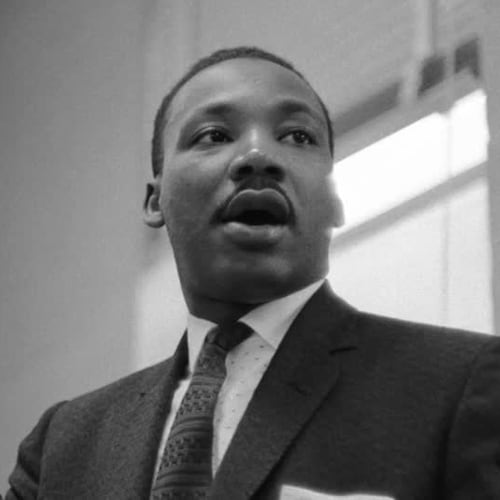There’s a treasure in the heart of the West End.
It’s been amassed over decades, but not hoarded. It isn’t hidden away in some chest or safe but is shown to the public — for free — at the art museums of Clark Atlanta University and Spelman College.
“This is a world treasure and people come from all over,” said Danille Taylor, the director of the CAU Art Museum.
Case in point: a painting owned by the historically Black college — “Woman in Blue” by William H. Johnson — is the featured image for the “Harlem Renaissance and Transatlantic Modernism” exhibition at New York’s famed Metropolitan Museum of Art. It is one of five pieces from Clark Atlanta that will be in the Met’s exhibit starting the end of February.
Two years ago, Clark Atlanta hosted an incredibly popular week-long exhibition of Jean-Michel Basquiat’s early works.
And the history of Black art from the 19th, 20th and 21st centuries can be seen through the more than 1,600 objects — paintings, sculptures, textiles, murals and more — in the permanent collections of the Clark Atlanta and Spelman museums.
It’s a history of oppression, of beauty, of survival, of making do, of surpassing circumstances.
Credit: Special
Credit: Special
The art history of the AUC
The Clark Atlanta museum has spent the past eight decades collecting African American and diasporic art and has a significant collection from the period between the early 20th century Harlem Renaissance and the Civil Rights Movement.
Works by Henry Ossawa Tanner, who the Smithsonian calls “[t]he most distinguished African-American artist of the nineteenth century,” are part of both Spelman and Clark’s collections.
But before he was a famed painter, Tanner was a professor at Clark College from 1888 to 1890, long before Clark merged with Atlanta University to become CAU. While in Atlanta, Tanner met a benefactor that sponsored a trip to Paris, where he grew his career and became the first Black American artist to receive international acclaim.
In 1931, an influential artist would join the faculty of Atlanta University, Hale Woodruff. While a professor, Woodruff studied mural painting with famed Mexican artist Diego Rivera. He would later paint six massive canvas panels, the “Art of the Negro” murals, that depict the cultural history of African and indigenous art forms and their impact on Western art and have been studied by international scholars.
The murals line the atrium of the CAU Art Museum, sitting above the card catalogs that nod to the space’s former life as a library.
Credit: arvin.temkar@ajc.com
Credit: arvin.temkar@ajc.com
But one of Woodruff’s most significant contributions to the school was a juried competition that he started in 1942, the Atlanta Art Annual.
The competition would go on every year until 1970, and in that time, about 900 Black artists from around the country participated and 291 of their works were purchased by the university, creating the foundation of the CAU collection.
Woodruff’s teaching and contributions to the Atlanta University art department boosted its prominence, so much so that it was considered at one point the “École des Beaux-Arts” of the Black South, according to the Smithsonian American Art Museum, a reference to the famed French school that produced renowned artists like Pierre-Auguste Renoir, Edgar Degas and John Singer Sargent.
CAU’s collection now has more than 1,200 works and is likely worth more than $100 million, according to Taylor, though it will be reappraised soon.
And the collections at the CAU and Spelman museums reflect the missions of the institutions where they are based.
“I think that this is a unique place because you can come and see world-class exhibitions for free,” said Liz Andrews, executive director of the Spelman College Museum of Fine Art. “You know that you will walk away with a deeper knowledge of history and contemporary topics with a focus on Black women. ... There’s no place in the country that does that.”
Credit: Olivia Bowdoin
Credit: Olivia Bowdoin
Spelman has about 450 works in its permanent collection, primarily by Black female artists. It includes works by the contemporary painter and Spelman alumna Calida Garcia Rawles and famed sculptor Elizabeth Catlett.
Andrews said Spelman also has the largest collection of works by the sculptor Selma Burke, who is the artist behind the portrait of President Franklin D. Roosevelt used on the dime. Spelman has the original relief that was miniaturized onto the coin.
CAU and Spelman have also collected contemporary Atlanta artists like Fahamu Pecou, the late Radcliffe Bailey, Morehouse professor Krista Clark and Sheila Pree Bright.
And the AUC has not just collected famous artists, but produced them as well. Amy Sherald, the artist behind the official portrait of former First Lady Michelle Obama, attended Clark Atlanta and took painting classes at Spelman.
Credit: AP
Credit: AP
An art history education
Despite decades of offering art education, the Atlanta University Center did not have an art history degree until six years ago, when the AUC Art History and Curatorial Studies Collective was launched.
It was created in response to a 2015 study by the Andrew W. Mellon Foundation that found only 16% of American museum leadership positions were held by minorities, despite making up 38% of the population. Only 4% of leaders were Black and just 3% were Hispanic.
In 2018, Spelman received a $5.4 million grant from the Walton Family Foundation that went to establishing the AUC art collective. Late last year the college renewed the grant, receiving this time $6.5 million for the next three years, according to Cheryl Finley, the collective’s founding director.
“Art history is our legacy,” said Finley.
The collective offers an art history major and minor as well as a minor in curatorial studies. Upperclassmen are placed in paid summer internships and there is a summer early college program open to high school students around the world.
Credit: Special
Credit: Special
Destinee Filmore was one of the first graduates of the AUC art collective. She graduated from Spelman in 2021 with a degree in art history. During her time in the program, she interned at the Cleveland Museum of Art and was accepted into a prestigious curatorial fellowship for her graduate studies.
Her journey to being a curator started in the Spelman art museum. Every freshman must take African Diaspora and the World classes, which brings them into the museum to write about a piece or a show. Filmore was working on her paper when she saw professors speaking to a small group of students in the museum. She eavesdropped on the lesson when the professors invited her to join. A few weeks later they invited her to an art history colloquium in Washington.
“It was so electrifying, I’d never gone to a conference like that,” said Filmore. “I was kind of smitten since then.”
In January, she started a new job as an assistant curator at the Met, a rarity for a 25-year-old curator.
“The things I learned at Spelman, the connections that I’ve made, the relationships that I maintain, and really the sort of endless support that I’ve received from people is what made it possible for me,” said Filmore.
Small but mighty
In the fall, Spelman held a show of 21 paintings and mixed media works by Harmonia Rosales, an Afro-Cuban American artist. In one of the showstoppers of the exhibit, Rosales reimagined Michelangelo’s Sistine Chapel. An overturned boat meant to represent slave ships served as the ceiling and was plastered with miniatures of her detailed, gilded oil paintings that merge stories of the West African Yorùbá culture with Greek mythology and Christianity.
Andrews placed a painting depicting the transatlantic slave trade, “The Migration of the Gods,” in the same room as the ship and on a wall that faced towards the Atlantic in a sort of prayerful meditation.
Credit: Olivia Bowdoin
Credit: Olivia Bowdoin
On Friday, Spelman opened its latest exhibit, “Threaded.” It includes quilts from Spelman and Clark Atlanta’s collections created by the Gee’s Bend Quilt Collective, a famous Alabama group of Black female quilters that have carried the tradition down from their enslaved ancestors. The show goes through May 24.
The CAU museum currently has on display an array of works from its permanent collection, CAU faculty and an artist-in-residence.
Credit: arvin.temkar@ajc.com
Credit: arvin.temkar@ajc.com
But the reality is that, though mighty, these are small museums.
“I’m having to build this community ... that supports us financially. We’re a little bit starting from scratch,” said Clark Atlanta’s Taylor.
But for Andrews, coming to the Spelman art museum from the much larger Los Angeles County Museum of Art in the fall of 2021 was a “no brainer.” She said she had always admired Spelman and had a deep respect for the museum, which others are also starting to see.
“I think that in a post-2020 moment, there was a renewed or even brand new interest for a lot of people in learning from HBCUs,” Andrews said.
Museums like the one in Los Angeles where Andrews previously worked or even Atlanta’s High Museum of Art, she said, “have a lot to learn from these museums because the work that places like CAU, Spelman … have been doing around the arts for decades, the artists we’ve been upholding and exhibiting and collecting are the very artists who have been barred from showing at major institutions for a long time.”
Credit: Olivia Bowdoin
Credit: Olivia Bowdoin
The museums also serve an important mission, not just in the art they collect, but in who they educate. Taylor said the CAU museum is often students’ first exposure to an art museum.
When students walk in to Spelman’s art museum, they see the cherry wood floors gleaming, the varnish shined to a mirror-finish. The art on the walls reflects on the floor as do the visitors, the two merging to create a new, living tableau that reveals the ultimate truth of the AUC museums: everyone is worthy of being considered an artist, everyone is worthy of being considered art. That’s where the treasure truly lies.
The Atlanta Journal-Constitution and Report for America are partnering to add more journalists to cover topics important to our community. Please help us fund this important work at ajc.com/give
About the Author
The Latest
Featured








